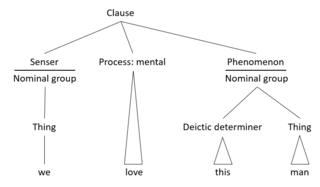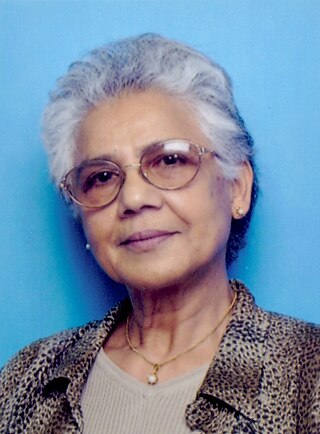Related Research Articles

Functional linguistics is an approach to the study of language characterized by taking systematically into account the speaker's and the hearer's side,and the communicative needs of the speaker and of the given language community. Linguistic functionalism spawned in the 1920s to 1930s from Ferdinand de Saussure's systematic structuralist approach to language (1916).

Michael Alexander Kirkwood Halliday was a British linguist who developed the internationally influential systemic functional linguistics (SFL) model of language. His grammatical descriptions go by the name of systemic functional grammar. Halliday described language as a semiotic system,"not in the sense of a system of signs,but a systemic resource for meaning". For Halliday,language was a "meaning potential";by extension,he defined linguistics as the study of "how people exchange meanings by 'languaging'". Halliday described himself as a generalist,meaning that he tried "to look at language from every possible vantage point",and has described his work as "wander[ing] the highways and byways of language". But he said that "to the extent that I favoured any one angle,it was the social:language as the creature and creator of human society".

Systemic functional grammar (SFG) is a form of grammatical description originated by Michael Halliday. It is part of a social semiotic approach to language called systemic functional linguistics. In these two terms,systemic refers to the view of language as "a network of systems,or interrelated sets of options for making meaning";functional refers to Halliday's view that language is as it is because of what it has evolved to do. Thus,what he refers to as the multidimensional architecture of language "reflects the multidimensional nature of human experience and interpersonal relations."
Deep structure and surface structure are concepts used in linguistics,specifically in the study of syntax in the Chomskyan tradition of transformational generative grammar.
In linguistics,the topic,or theme,of a sentence is what is being talked about,and the comment is what is being said about the topic. This division into old vs. new content is called information structure. It is generally agreed that clauses are divided into topic vs. comment,but in certain cases the boundary between them depends on which specific grammatical theory is being used to analyze the sentence.
Rodney D. Huddleston is a British linguist and grammarian specializing in the study and description of English.

Systemic functional linguistics (SFL) is an approach to linguistics,among functional linguistics,that considers language as a social semiotic system.

Relational Network Theory (RNT),also known as Neurocognitive Linguistics (NCL) and formerly as Stratificational Linguistics or Cognitive-Stratificational Linguistics,is a connectionist theoretical framework in linguistics primarily developed by Sydney Lamb which aims to integrate theoretical linguistics with neuroanatomy. It views the linguistic system of individual speakers,responsible for language comprehension and production,as consisting of networks of relationships which interconnect across different "strata" of language. These relational networks are hypothesized to correspond to neural maps of cortical columns or minicolumns in the human brain. Consequently,RNT is related to the wider family of cognitive linguistic theories. Furthermore,as a functionalist approach to linguistics,RNT shares a close relationship with Systemic Functional Linguistics (SFL).

Ruqaiya Hasan was a professor of linguistics who held visiting positions and taught at various universities in England. Her last appointment was at Macquarie University in Sydney,from which she retired as emeritus professor in 1994. Throughout her career she researched and published widely in the areas of verbal art,culture,context and text,text and texture,lexicogrammar and semantic variation. The latter involved the devising of extensive semantic system networks for the analysis of meaning in naturally occurring dialogues.
Lexicogrammar is a term directly related to systemic functional linguistics. Systemic functional linguistics is a specific approach to adding as much detail as possible when describing lexicogrammar. It was coined by Michael Halliday,the father of systemic functional linguistics,to describe the continuity between grammar and lexis. For many linguists,these phenomena are discrete. But Halliday brings them together with this term. As with other dimensions of Halliday's theory,he describes the relation of grammar to lexis as one of a 'cline',and therefore,one of 'delicacy'. In 1961,he wrote 'The grammarian's dream is...to turn the whole of linguistic form into grammar,hoping to show that lexis can be defined as "most delicate grammar". In 1987,Ruqaiya Hasan wrote an article titled 'The grammarian's dream:lexis as delicate grammar',in which she laid out a methodology for mapping lexis in Halliday's terms.

James Robert Martin is a Canadian linguist. He is Professor of Linguistics at The University of Sydney. He is the leading figure in the 'Sydney School' of systemic functional linguistics. Martin is well known for his work on discourse analysis,genre,appraisal,multimodality and educational linguistics.

Christian Matthias Ingemar Martin Matthiessen is a Swedish-born linguist and a leading figure in the systemic functional linguistics (SFL) school,having authored or co-authored more than 100 books,refereed journal articles,and papers in refereed conference proceedings,with contributions to three television programs. One of his major works is Lexicogrammatical cartography (1995),a 700-page study of the grammatical systems of English from the perspective of SFL. He has co-authored a number of books with Michael Halliday. Since 2008 he has been a professor in the Department of English at the Hong Kong Polytechnic University. Before this,he was Chair of the Department of Linguistics at Macquarie University in Sydney.
The term metafunction originates in systemic functional linguistics and is considered to be a property of all languages. Systemic functional linguistics is functional and semantic rather than formal and syntactic in its orientation. As a functional linguistic theory,it claims that both the emergence of grammar and the particular forms that grammars take should be explained "in terms of the functions that language evolved to serve". While languages vary in how and what they do,and what humans do with them in the contexts of human cultural practice,all languages are considered to be shaped and organised in relation to three functions,or metafunctions. Michael Halliday,the founder of systemic functional linguistics,calls these three functions the ideational,interpersonal,and textual. The ideational function is further divided into the experiential and logical.

The cline of instantiation is a concept in systemic functional linguistics theory. Alongside stratification and metafunction,it is one of the global semiotic dimensions that define the organization of language in context.
The idea of language as a linguistic system appears in the linguistic theory of Ferdinand de Saussure,J.R. Firth,Benjamin Lee Whorf,Louis Hjelmslev,and Michael Halliday.
The Sydney School is a genre-based writing pedagogy that analyses literacy levels of students. The Sydney School's pedagogy broadened the traditional observation-based writing in primary schools to encompass a spectrum of different genres of text types that are appropriate to various discourses and include fiction and non-fiction. The method and practice of teaching established by the Sydney School encourages corrective and supportive feedback in the education of writing practices for students,particularly regarding second language students. The Sydney School works to reflectively institutionalise a pedagogy that is established to be conducive to students of lower socio-economic backgrounds,indigenous students and migrants lacking a strong English literacy basis. The functional linguists who designed the genre-based pedagogy of the Sydney School did so from a semantic perspective to teach through patterns of meaning and emphasised the importance of the acquisition of a holistic literacy in various text types or genres. ‘Sydney School’is not,however,an entirely accurate moniker as the pedagogy has evolved beyond metropolitan Sydney universities to being adopted nationally and,by 2000,was exported to centres in Hong Kong,Singapore,and parts of Britain.
Alice Marie-Claude Caffarel-Cayron is a French-Australian linguist. She is an Honorary Senior Lecturer in Linguistics at the University of Sydney. Caffarel is recognized for the development of a Systemic Functional Grammar of French which has been applied in the teaching of the French language,Discourse analysis and Stylistics at the University of Sydney. Caffarel is recognised as an expert in the field of French Systemic Functional Linguistics (SFL).
Frances Helen Christie,is Emeritus professor of language and literacy education at the University of Melbourne,and honorary professor of education at the University of Sydney. She specialises in the field of systemic functional linguistics (SFL) and has completed research in language and literacy education,writing development,pedagogic grammar,genre theory,and teaching English as a mother tongue and as a second language.
Suzanne Eggins is an Australian linguist who is an Honorary Fellow at Australian National University (ANU),associated with the ANU Institute for Communication in Health Care. Eggins is the author of a best selling introduction to systemic functional linguistics and she is known for her extensive work on critical linguistic analysis of spontaneous interactions in informal and institutional healthcare settings.
Robin P. Fawcett is a British linguist known as the main exponent of the Cardiff grammar in systemic functional linguistics. He is Emeritus Professor at Cardiff University.
References
- 1 2 García, Adolfo M.; Sullivan, William J.; Tsiang, Sarah (2017). An Introduction to Relational Network Theory. Sheffield: Equinox.
- ↑ Lamb, Sydney. "Sketch". Rice University. Retrieved 16 May 2024.
- ↑ Lockwood, David G.; Fries, Peter H.; Copeland, James E. (eds.). Functional Approaches to Language, Culture, and Cognition. John Benjamins.
- ↑ Makkai, Adam. "CV". Adam Makkai's website. Retrieved 16 May 2024.
- ↑ "PhD Alumni". Yale University, Department of Linguistics. Retrieved 16 May 2024.
- ↑ Lamb, Sydney M. "Encyclopædia Britannica". Johannes Gutenberg University Mainz. Retrieved 2010-12-09.
- ↑ "Sydney M Lamb (Rice University)" . Retrieved 2024-04-20.
- ↑ Lamb, Sydney M. "Systemic networks, relational networks and choice". In Fontaine, Lise; Bartlett, Tom; O'Grady, Gerard (eds.). Systemic Functional Linguistics: Exploring Choice. Cambridge University Press. Retrieved 2024-04-20.
- ↑ Lamb, Sydney (2004). Language and Reality: Selected Writings of Sydney Lamb. Continuum. p. 12.
- ↑ Lamb, Sydney. A Grammar of Mono. PhD. Dissertation. Berkeley, 1958.
- ↑ Lamb, Sydney (2004). Language and Reality: Selected Writings of Sydney Lamb. Continuum. pp. 12–13.
- ↑ Justia. "Patents Assigned to Semionics Associates". Justia. Retrieved 14 May 2024.
- ↑ Lamb, Sydney (2004). Language and Reality: Selected Writings of Sydney Lamb. Continuum. p. 13.